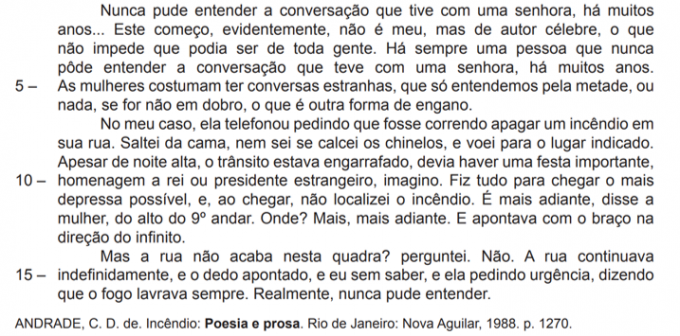O polysyndetonis a figure of speech which uses the repetition of conjunctions to generate a stylistic effect, usually one of emphasis or intensification. Its use must be moderate so that the text does not become repetitive, especially in non-literary texts.
Read too: Hyperbole — the figure of speech that uses exaggeration in expressions to emphasize speech
Summary about polysyndeton
- The polysyndeton is a figure of speech that uses the repetition of conjunctions to give some stylistic effect, usually emphasis or intensification.
- Specifically, is a syntax figure (or construction).
- Its use must be moderate so that the text does not become tiring.
- It is often used in poems and songs.
What is polysyndeton?
The polysyndeton is a figure of speech that uses the repetition of conjunctions to give some stylistic effect. Generally, it intensifies and emphasizes an idea. It already shows its meaning in the name itself: poly means “many” and syndet means “connection” or, in grammar, “conjunction”. Thus, the polysyndeton is part of the figures of syntax (or construction), a subgroup of figures of speech that use unusual syntactic constructions.
- Example 1:
In the comfort
From the cloister, in patience and peace,
It works, It is stubborn, It is lime, It is suffer, It isyours!|1|
In the excerpt from the poem “To a Poet”, by Olavo Bilac, the lyrical self uses the polysyndeton. The repetition of the conjunction “and” reinforces the idea of the difficulty and work involved in writing a poem.
- Example 2:
The world is big It is fits
in this window over the sea.
The sea is big It is fits
in the bed and on the mattress to love.
Love is great It is fits
in the brief space of kissing |2|
In the poem “O mundo é grande”, by Carlos Drummond de Andrade, the author uses the polysyndeton in a innovative: the conjunction “and”, which is usually used to reinforce, has an adversative meaning, that is, of opposition. In this case, she opposes two ideas: things are big, but they fit into small spaces or moments. These verses can be understood this way:
The world is big, butfits in this window over the sea.
The sea is big, but fits the bed and the mattress to love.
Love is great, but fits in the brief space of kissing.
- Example 3:
And speaking of beauty
Where is the song going?
That could be heard in the night
From the bars of then
Where we stayed
Where we loved each other
In total solitude
In the song “Onde anda Você”, by Toquinho and Vinicius de Moraes, the repetition of the conjunction “onde” returns and reinforces the idea that the environment in which the lovers found themselves is no longer accessible.
How to use polysyndeton?
In general, the polysyndeton is used artistically to reinforce an idea, which can be close or even oppositional. However, the author must be careful that repetition does not make the text tiring, especially in non-literary texts. Below, we will see examples of the use of this figure with clear and appropriate objectives.
- Example 1:
At the free market in Arrebaldezinho
A loquacious man proclaims little colored balloons:
— “The best fun for children!”
Around him there is a gathering of poor little boys,
Staring with very round eyes at the big, very round balloons.
However, the fair is buzzing.
The poor bourgeoisies are arriving,
ANDthe maids of the rich bourgeoisies,
ANDwomen of the people, It is the nearby washerwomen.
At the fish stalls,
At the cereal stalls,
Next to the vegetable baskets
The penny is haggled over with acrimony.
Poor boys don't see the tender peas,
The little red tomatoes,
Nor the fruits,
Noranything.
It feels good that for them there at the fair, the little colored balloons are the only useful and truly indispensable merchandise.
The indefatigable salesman touts:
— “The best fun for children!”
And around the loquacious man the poor little boys form an immovable circle of desire and amazement.|3|
In the poem “Balõezinhos”, by Manuel Bandeira, the polysyndeton occurred in two moments. In the second stanza, the repetition of “e” enumerates, according to the voice of the poem, the groups that are arriving and helps to reinforce the socioeconomic difference between them. Something similar occurs in the fourth stanza, in which the use of “nem” intensifies the idea that boys, even poor ones, can only pay attention and be enchanted by the balloons.
- Example 2:
Our sacred sweat
It's much more beautiful
That this bitter blood
AND so serious
AND wild! Wild!
In the excerpt from the song “Tempo Perdido”, by the band Legião Urbana, the polysyndeton of the conjunction “e” is used to reinforce the characteristics of “blood” and makes it more intense.
What is the difference between polysyndeton and anaphora?
The polysyndeton and anaphora are two figures of speech. The anaphora makes reference to something already said in the text, replacing it with synonyms, pronouns or just repeating the word. Polysyndeton uses the repetition of conjunctions to create a stylistic effect. Repetition is what can cause confusion between the two figures, but anaphora deals with all grammatical classes, not just conjunctions. Look:
Mariana bought fruit. She ate bananaThe It islitter It isstrawberry.
In the example, “Ela” is an anaphora, as it repeats “Mariana”, while the repetition of “e” is a polysyndeton.
What is the difference between polysyndeton and asyndeton?
Polysyndeton and asyndeton are two opposing figures of speech. As syndet means “connection” or, in grammar, “conjunction”, we know that the polysyndeton is a figure of speech that uses the repetition of conjunctions (poly = very), while asyndeton (a = not) is a figure of speech that does not use any conjunctions.
Today, we went to the park. We don't eat, but we jump, but we joke, but we spin! (polysyndeton)
Today, we went to the park. We don't eat; we jump, we play, we spin! (asyndeton)
Other figures of speech
Figures of speech are ways of modifying traditional speech, which can occur by manipulating meaning, sounds, syntactic construction, ideas. It is in this context that figures of speech are divided into: figures of words (or semantics), syntax (or construction), thought and sound.
Some examples of figures of speech are:
- Anacoluto (break in the syntactic structure of the sentence):That cousin of mine, I never imagined he would be fired.
- Silepsis (verbal and nominal agreement by meaning, not by grammatical rules):The people, I heard, made a demonstration.
- Personification (giving human elements to inanimate beings):The Sun smiles to her every morning.
See too: Metaphor — the figure of speech used to make comparisons implicitly
Solved exercises on polysyndeton
Question 1
(UFBA)

The period “The street continued indefinitely, and the finger was pointed, and I didn't know it, and she asked for urgency, saying that the fire was always raging.” (l. 14-16) predominantly presents independent, coordinated clauses and the polysyndeton syntax figure.
( ) Right
( ) Wrong
Resolution:
Right
There is the polysyndeton through the repetition of the conjunction “and”, and the relationships are coordinated because they function independently of each other (I without knowing. She asking for urgency.).
Question 2
(IFPA)
Rivers without speech
When a river cuts, it cuts once and for all
the river-speech he made;
cut, the water breaks into pieces,
in water wells, in paralytic water.
In a well situation, the water is equivalent
to a word in a dictionary situation:
isolated, stuck in her own well,
and because it is so stagnant, stagnant;
and more: because stuck like this, it changes,
and it changes because it communicates with none,
because the syntax of that river was cut,
the trickle of water through which he ran.
[...]
(MELO NETO, João Cabral de. Education through stone, P. 350-351)
The text “Rivers without speech” is metaphorical, and in more detail we can identify other figures of speech. Mark the alternative whose excerpt taken from the aforementioned text presents a polysyndeton:
- “When a river cuts, it cuts once and for all
the river-speech he made;”
- “In a well situation, water is equivalent to
to a word in a dictionary situation:”
- “because the syntax of that river was cut,
the trickle of water through which he ran.”
- “cut, the water breaks into pieces,
in water wells, in paralytic water.”
- “and because it is so stagnant, stagnant;
and more: because stuck like this, it changes,
and it changes because it doesn’t communicate with anyone”
Resolution:
Alternative E
There is polysyndeton due to the repetition of the conjunction “and”, which reinforces the sense of cause and consequence in the poem.
Grades
|1|ROCHA LIMA. Normative grammar of the Portuguese language: revised edition according to the new Orthographic Agreement. Rio De Janeiro: Editora José Olympio, 2017.
|2|CHAVES, C. W. Stylistic aspects in the use of conjunctions. Palimpsest,v. 10, no. 13, p. 1-12, 2011. Available in: https://www.e-publicacoes.uerj.br/index.php/palimpsesto/article/view/35355.
|3| BANDEIRA, M. Little balloons. In: The dissolute rhythm. São Paulo: Editora Global, 2014.
Sources
BANDEIRA, M. Little balloons. In: The dissolute rhythm. São Paulo: Editora Global, 2014.
CHAVES, C. W. Stylistic aspects in the use of conjunctions. Palimpsest,v. 10, no. 13, p. 1-12, 2011. Available in: https://www.e-publicacoes.uerj.br/index.php/palimpsesto/article/view/35355.
ROCHA LIMA. Normative grammar of the Portuguese language: revised edition according to the new Orthographic Agreement. Rio De Janeiro: Editora José Olympio, 2017.

